This page is a practical guide to cleaning an iron at home and a curated roundup of products that deliver visible results with minimal hassle. Whether you’re ironing delicate fabrics like modal or using the cotton setting on iron for crisp linens, a clean iron ensures pristine results.
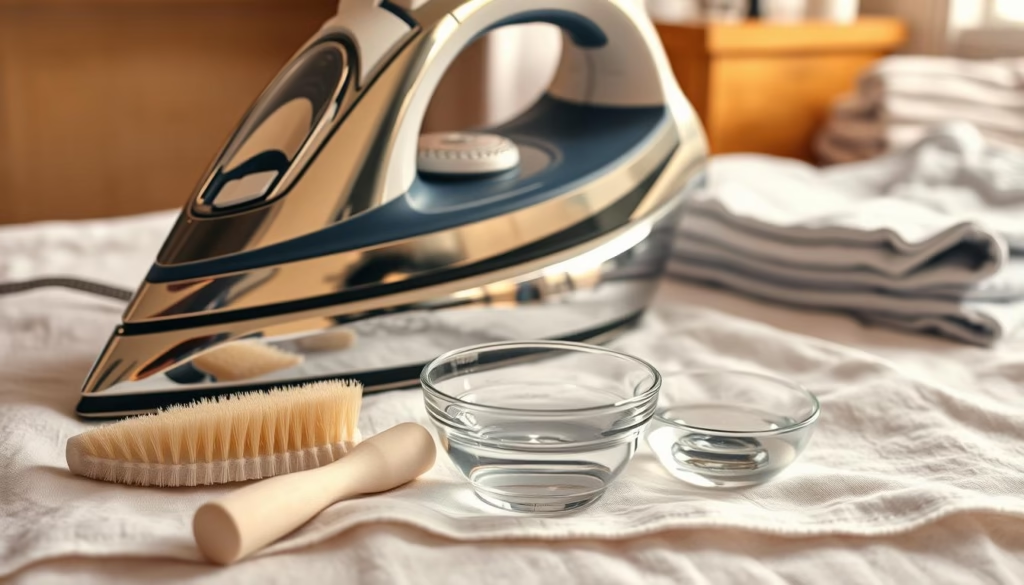
Mineral buildup and sticky residue on the soleplate or inside the reservoir cause drag, scorches, and transfer of fabric residue. A simple routine stops those issues and helps your iron glide smoothly, protecting clothes from damage like modal fabric shrink or unsightly marks.
We show quick fixes, deeper maintenance steps, and a shopping path so you can move from immediate fixes to longer care. You can shop a carefully selected set of tools—non-scratch pads, a soft cloth, and accessories—organized by budget and design tastes, perfect for your laundry setup alongside shelf plants or decorative peperomia pixie lime for a touch of green.
Expect items that prioritize quality, durable materials, and smart design details that won’t harm modern nonstick or ceramic soleplates. Selections consider U.S. availability, support, and domestic shipping thresholds so your purchase experience feels effortless.
Key Takeaways
- Follow simple home steps to prevent buildup and fabric damage.
- Use gentle tools that protect nonstick and ceramic soles.
- Shop curated products by budget and design preference.
- Regular care gives measurable results: faster pressing and fewer marks.
- Selections factor in U.S. shipping, support, and quality standards.
Why a Clean Iron Matters for Pristine Clothes at Home
Hard water deposits and cooked-on sizing can block steam holes and roughen the iron’s surface. This buildup cuts steam flow and changes how heat transfers to fabric, potentially causing issues like modal fabric shrink on delicate items or shiny patches on variegated leaves-patterned clothing.
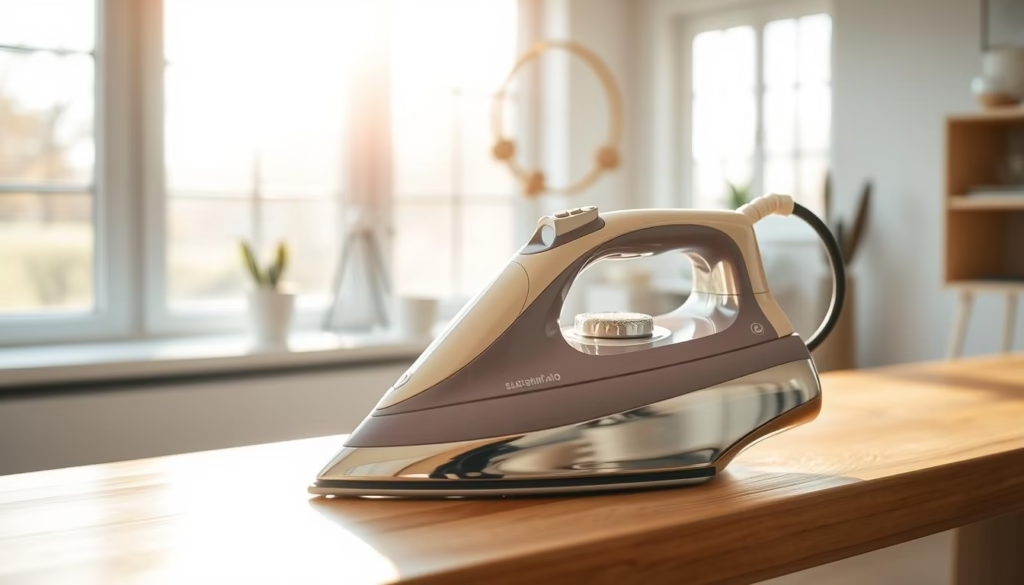
When vents clog or adhesive residues bake onto the soleplate, the iron drags and leaves marks. Over time, this causes gray streaks, shiny patches, and water spotting that dull garments, much like how a cracked toilet bowl can lead to unexpected leaks if ignored.
Preventive care keeps fabrics looking newer and reduces the chance of snagging or scorching. A quick wipe after each session and a deeper descaling every few months preserves temperature accuracy and steady steam for cotton, linen, silk blends, and synthetics, including delicate pieces like a strawberry shake philodendron-inspired blouse.
- Quick interval: Wipe the soleplate after use.
- Deep interval: Descale every 2–4 months (softer water = less often).
- Value: Routine maintenance avoids premature replacement and protects your wardrobe.
Regular care is a small step that saves garments and keeps pressing consistent across fabric types.
| Issue | Cause | Effect on Clothing | Maintenance Tip |
|---|---|---|---|
| Clogged vents | Mineral scale | Uneven steam, spots | Descale with vinegar or manufacturer solution |
| Sticky soleplate | Polymerized starch or adhesive | Gray streaks, drag | Use a non-scratch pad and wipe warm |
| Temperature drift | Internal deposits | Scorch risk, poor press | Regular deep clean every few months |
For more practical steps, this guide later shows fast routines and full descaling methods. The information there will help you keep ironing efficient and protect the quality of your garments, whether in an average dimensions of a living room laundry setup or a compact space.
Quick Start: Minimal Effort Steps to Clean Your Iron Today
Start with small, focused steps to get an iron working like new again. These quick actions require minimal effort and basic tools to improve glide and clear vents in minutes, perfect for keeping your cotton setting on iron performing flawlessly.
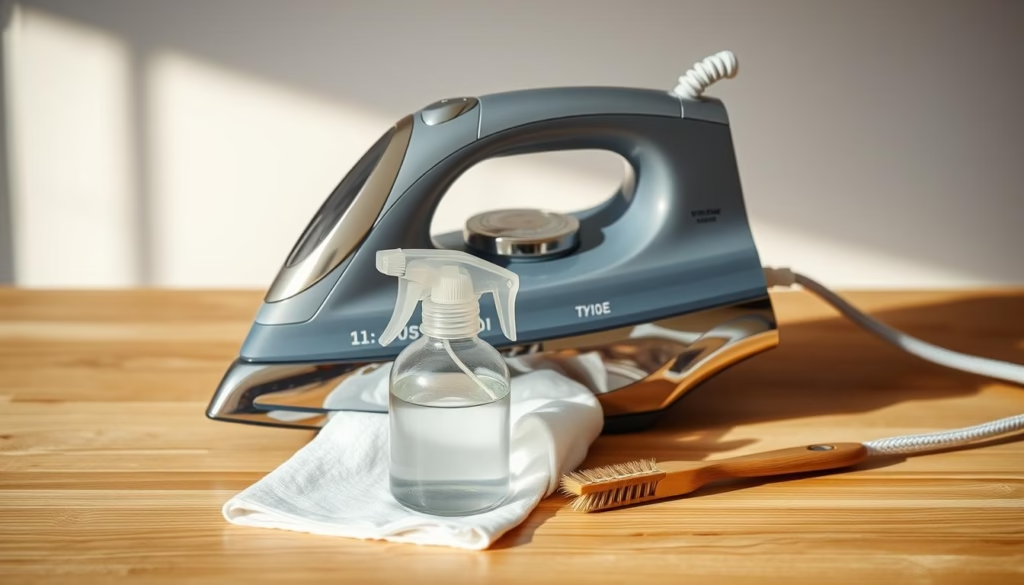
- Unplug, cool, and empty the reservoir
Safety first. Unplug the iron and let it cool fully. Empty the water tank to avoid leaks while you work. - Wipe the soleplate with a damp cloth or paper towel for instant results
Set up a simple cleaning setup: a soft, damp microfiber cloth or a paper towel for quick exterior and soleplate wipes, similar to how to clean tweezers for precision tools.
Gently wipe the soleplate in one direction. Moisture lifts light residue without scratching. Dry with a lint-free wipe before reheating. - De-gunk with cotton swabs and a soft pad
Use cotton swabs to clear steam vents and edges. Rotate to a clean side so you don’t redeposit grime.
For sticky spots, apply light pressure with a non-scratch pad. Avoid steel wool or harsh scouring tools that can damage the finish, much like you’d avoid abrasive tools on bath sheets vs bath towels.
“Small, routine steps keep your iron safe and your garments looking their best.”
- Start with safety: Unplug, cool, and empty the reservoir.
- Set up simple tools for quick wipes and targeted cleaning.
- Finish by drying the soleplate and, if you have time, run a short steam pulse with distilled water to clear vents.
| Step | Tool | Expected Result |
|---|---|---|
| Power off & empty | — | No leaks; safe handling |
| Wipe soleplate | Microfiber or paper towel | Smoother glide; removed surface grime |
| Clear vents | Cotton swabs | Improved steam flow; fewer spots |
| Remove sticky residue | Non-scratch pads | No scratches; restored finish |
Essential Tools: Super Absorbent Cloth, Pads, and Accessories
A compact kit of the right tools makes regular iron care fast and effective. Pick a few dependable items and keep them near the board so maintenance becomes simple and routine, just like organizing shelf plants for a tidy laundry nook.
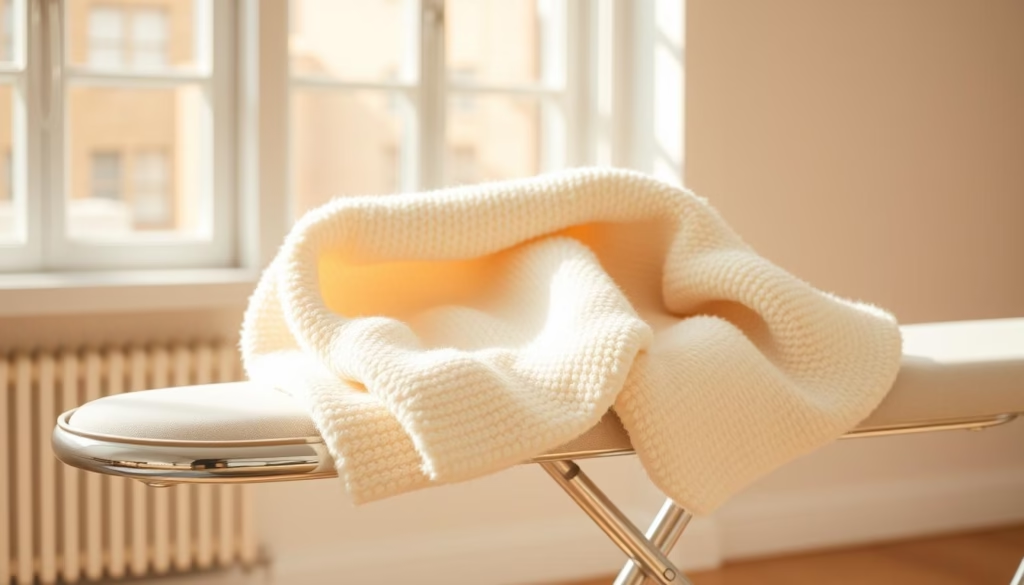
- Reusable microfiber for everyday wipe-downs
Choose a reusable microfiber piece with super absorbent performance. A damp microfiber lifts residue without scratching nonstick and ceramic finishes. Look for antimicrobial and durable weaves that hold up to frequent washing. - Non-scratch pads for stubborn buildup
Select non-scratch pads made for coated cookware and appliances. They remove baked-on starch and polymerized sizing without abrasion. Keep one pad reserved for the iron to avoid cross-contamination. - Distilled water, swabs, and disposable options
Keep distilled water to steam and descale—this reduces mineral redeposits. Stock cotton swabs for vents and paper towels as a disposable option for heavy grime, similar to cleaning delicate peperomia pixie lime leaves. - Favor washable, long-lasting pieces that cut waste and save money.
- Consider a small selection of tools so upkeep is quick and effortless.
Product Roundup: Best Sellers to Clean Your Iron with Minimal Effort
A small, curated kit of proven tools cuts cleaning time and improves pressing results. Below are top choices—value picks, premium options, and reusable pads—that help you shop smart and keep your iron in peak condition, whether you’re pressing variegated leaves-patterned fabrics or everyday cottons.
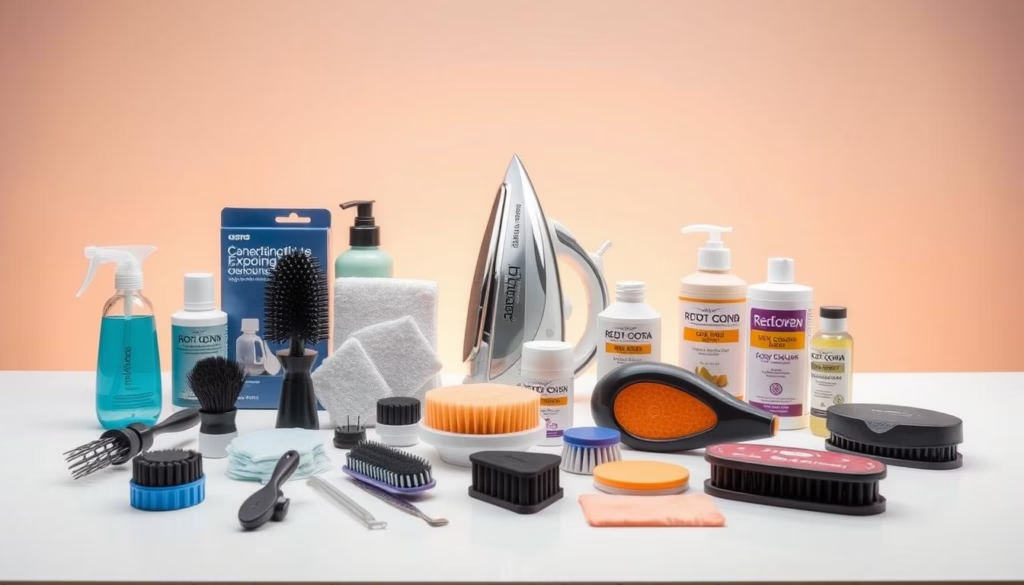
- Top super absorbent options for streak-free results
Best sellers here focus on microfiber density and edge stitching to prevent fray. Look for GSM ratings between 250–350 for fast pickup and low lint. - Value picks under $15 USD
For a low-cost start, shop bundles that include washable, lint-free weaves. These products deliver good results for a modest price and make a practical starter kit. - Premium, design-forward choices
Premium sellers emphasize bound edges, hang loops, and thoughtful finishes. Higher quality materials mean fewer replacements and better long-term performance. - Reusable pads that lift residue without scratching
Non-scratch pads engineered for coated surfaces remove polymerized residue while protecting ceramic and nonstick soleplates. They pair well with distilled water and a soft wipe.
| Category | What to Look For | Expected Result | Price Range (USD) |
|---|---|---|---|
| Best sellers | High GSM, stitched edges | Streak-free finish | $10–$25 |
| Value picks | Washable, lint-free weave | Good cleaning; low cost | Under $15 |
| Premium | Bound edges, hang loops | Durable, polished look | $20–$45 |
| Reusable pads | Non-abrasive material | Lifts residue; protects soleplate | $8–$30 |
Spotlight on Reusable Innovation: Kula Cloth®-Inspired Features
Modern reusable wipes bring appliance care into the same thoughtful design world as outdoor gear and maker tools. Kula-style pieces emphasize materials and small details that matter for daily ironing routines, perfect for a laundry room styled with shelf plants or strawberry shake philodendron accents.
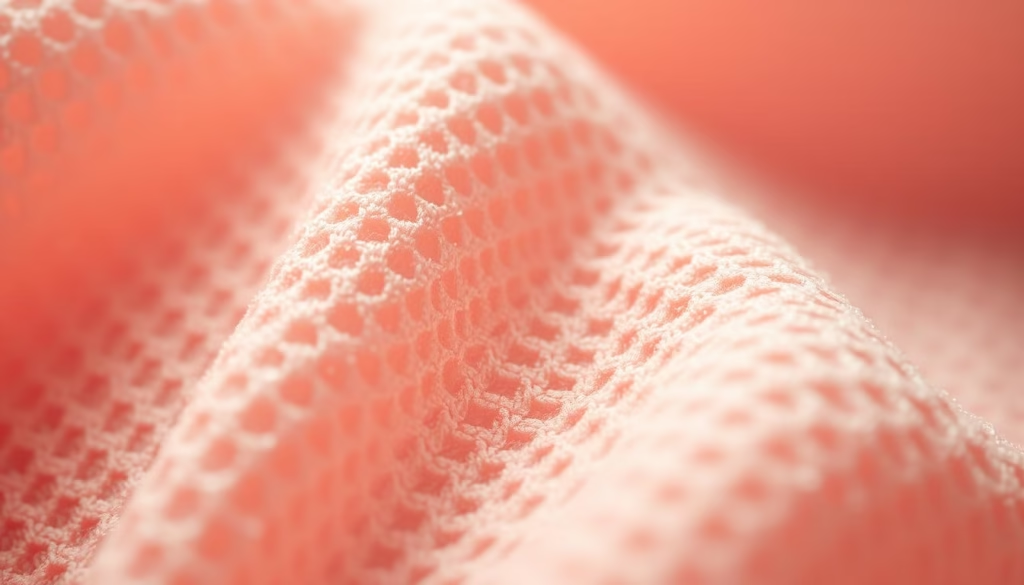
- Super absorbent and antimicrobial traits
Fast moisture pickup shortens cleanup time and cuts odor between washes. Antimicrobial finishes help the item stay fresh after repeated use. That matters when you wipe a warm soleplate or blot steam drips. - Waterproof, durable, and reusable benefits
A waterproof backing prevents moisture transfer to boards and counters. Durable construction means fewer replacements and less waste. Over time, consistent performance keeps pressing easier and protects garments. - Reflective thread and portability for travel irons
Reflective thread adds visibility in dim laundry rooms or when packing for a trip. Snaps, loops, and compact sizing make the piece easy to hang on carts or attach to a tote.
“Smart materials and purposeful details turn routine care into a simple, reliable habit.”
- Indoor performance: Quick pickup and less odor.
- Surface-safe: Waterproof backing for damp stations.
- Travel-ready: Snaps and reflective accents for easy access.
Luxury Look, Practical Clean: Design and Quality Cues from CLOTH & PAPER
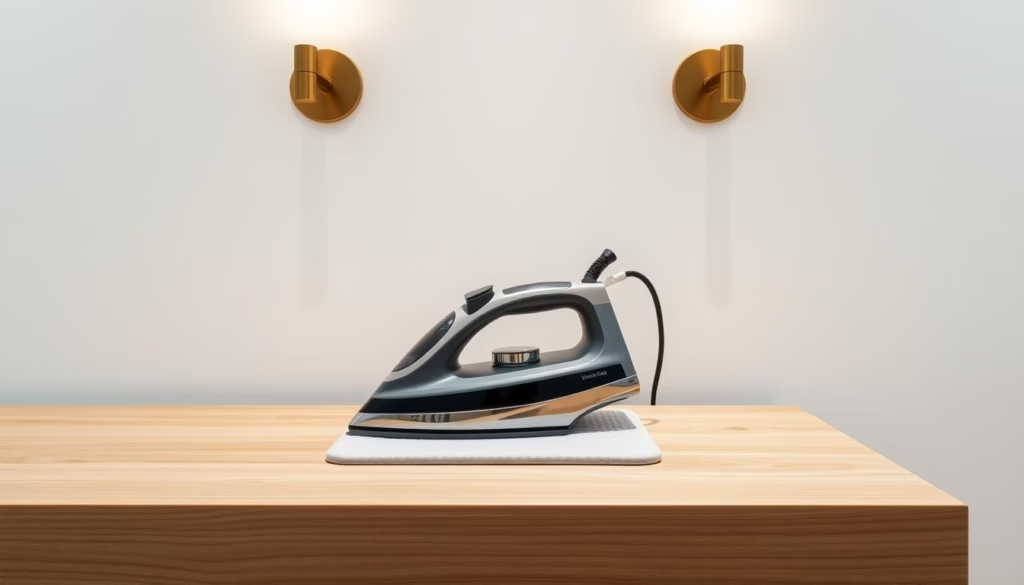
A curated workspace with cohesive pieces reduces friction and improves routine care. When tools are attractive and placed with intent, you use them more often. This section borrows planner-led ideas to make cleaning both practical and pleasing, complementing a stylish average dimensions of a living room laundry setup.
- Beautifully designed essentials for a refined cleaning station
Choose a cohesive palette for storage, labeled containers, and textured finishes that match your laundry room. These small design cues make the station feel intentional. - Best sellers anchor the kit: A reliable non-scratch pad, a super-absorbent wipe, and a compact storage tray. Use these trusted pieces as the foundation, then add specialty tools for vents and pads.
- Organized “setup” inspired by planner dividers and accessories
Follow a four-step flow—choose, layer, organize, add—to structure your kit. Layer lightweight items for daily use and tuck deeper tools behind dividers. This mirrors a planner’s setup and speeds access. - Reference top picks for reliability, then personalize your selection.
- Look for brands with exceptional support and active community tips to refine your routine.
When you shop, favor pieces that balance form and function to keep care consistent.
“Elevated design helps good habits stick—when tools look right, you reach for them.”
Paper vs Cloth: Which Option Delivers Better Results for Your Iron?
The item you reach for—paper or reusable—shapes how clean and protected your iron will be. Choose based on the mess, time, and long-term goals for care, similar to choosing bath sheets vs bath towels for absorbency.
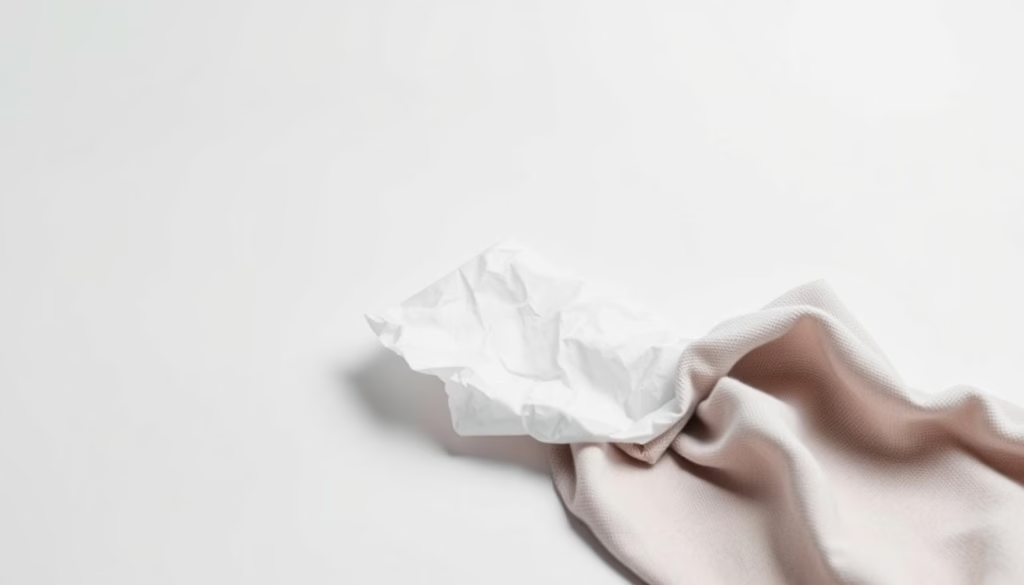
- When a paper towel is enough
Use a paper towel for quick, disposable cleanups on a fully cooled soleplate. It works well for light spills or a single sticky spot. - When a reusable cloth wins on quality and value
Damp microfiber removes surface residue without scratching and leaves fewer fibers than paper. A reusable cloth gives better control around vents and polishes to a streak-free finish. - Reducing waste over the years with reusable options
Microfiber endures dozens of wash cycles, lowering recurring spend and trash. The eco and practical wins are fewer roll changes, steady performance, and better results over time.
“A hybrid approach works best: paper for one-off messes; microfiber for routine maintenance and final polishing.”
| Use Case | Best Pick | Benefit |
|---|---|---|
| Quick single mess | Paper towel | Fast, disposable |
| Routine maintenance | Microfiber cloth | Lint-free, streak-free results |
| Long-term cost | Reusable | Lower cost across years |
Sizes, Colors, and Pieces: Building the Right Cleaning Kit
Build a compact kit that suits your iron’s size and the tasks you’ll do most often. A tidy selection speeds care and keeps tools ready when you need them, whether in a compact laundry space or an average dimensions of a living room setup.
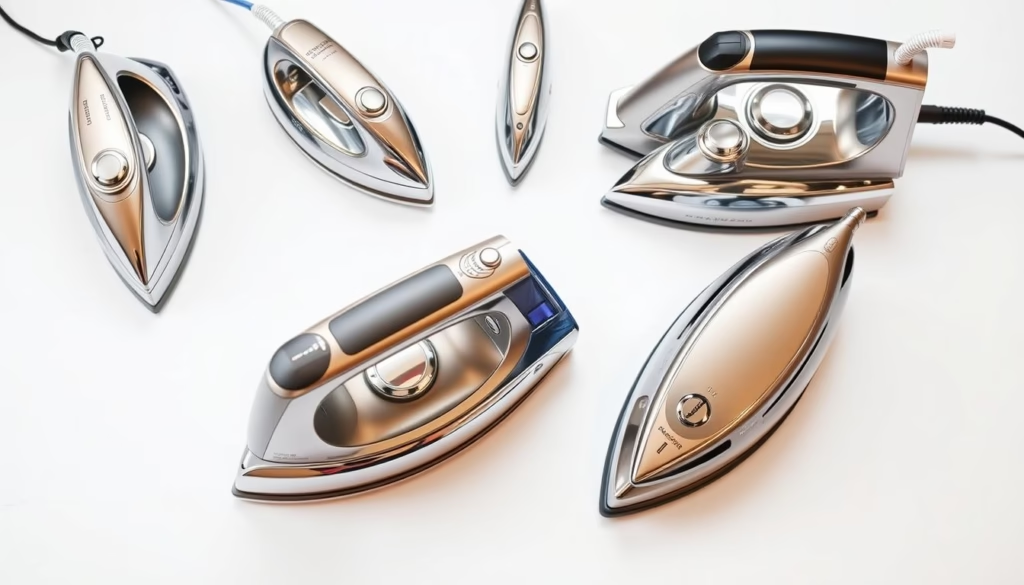
- Cloth size and thickness by soleplate
Match the wipe to the soleplate. Larger irons benefit from 12″×12″ or bigger wipes to cover the whole surface in fewer passes. Travel and compact irons pair well with 8″–10″ pieces for control.
Choose a medium-pile weave (GSM in the mid-range). It soaks up residue without flopping or bunching, giving steady pressure and good pickup. - Color-coding your kit for different tasks
Use plain colors to prevent cross-contamination. Assign one color for the soleplate, another for exteriors, and a third for reservoir spills or steam drips.
Simple color rules reduce mistakes and speed sorting between laundry days. - How many pieces you really need to start
Begin with a minimal setup: two microfibers, one non-scratch pad, cotton swabs, and distilled water. Add a vent brush or heat-resistant mat only when you need them.
“Start small and expand—this keeps the kit useful and clutter-free.”
| Item | Suggested Size | Why It Matters |
|---|---|---|
| Everyday wipe | 12″×12″ | Covers large soleplates quickly |
| Travel wipe | 8″–10″ | Better control on compact irons |
| Non-scratch pad | Single piece | Removes baked-on residue safely |
| Extras | Vent brush, mat | Add as needs emerge |
Prices, Sales, and Value: How to Shop Smart in USD
Smart shopping stretches your budget and keeps high-quality pressing tools within reach. Read everyday numbers and sale tags to spot real savings, not just hype, especially for tools as essential as those for how to clean tweezers or iron care.

- Everyday price vs. sale price
Start by comparing the regular price to the sale price. A short-lived discount often drops the tag for limited time, while true markdowns appear across multiple cycles.
Track the USD amount you expect to spend and set alerts on items you want. That way your purchase hits during a real sale and not a small promo. - Best value bundles and curated lists
Bundles can offer the biggest value. For example, CLOTH & PAPER advertises “As low as $45 — receive $130+ of beautifully designed essentials.” That kind of pack reduces per-item USD cost.
Follow curated lists and top sellers. Prioritize items that rarely get deep discounts and add bundled extras when they lower the combined price. - Plan purchases before heavy cleaning seasons to save time and money.
- Use subscriptions or rewards for early access and points on repeat orders.
- Always check order minimums, taxes, and shipping thresholds before you complete a purchase.
Shipping, Orders, and Support: Smooth Purchase Experience in the United States
A well-run shipping process keeps restocks timely and your pressing routine uninterrupted. That reliability starts at checkout and continues through delivery, returns, and customer care.
- Free US domestic shipping thresholds and promos
Free US domestic shipping is available on qualifying orders of $90 or more, or with any active subscription purchase. This threshold can lower your total cost when you shop for kits and repeat essentials.
Compare carriers and delivery windows, especially in peak seasons. Choosing standard over expedited often saves fees but check expected delivery dates when you need items quickly. - Order support and community engagement
Keep clear order notes for gift messages or split shipments to avoid mix-ups. Review return policies for pads and opened items—hygiene rules can affect eligibility.
Flag the free-shipping threshold when planning larger orders.
Document special delivery notes at checkout for smoother fulfillment.
Join brand communities or subscriber programs for restock alerts and insider tips. - Prioritize sellers with fast, friendly support to resolve issues quickly.
“Exceptional support and active communities make buying, receiving, and maintaining your kit simple and dependable.”
Step-by-Step Guide: From Setup to Sparkling Soleplate
Set up a tidy station and follow a few focused moves to restore steam performance. This short guide walks you through the safe sequence: prepare, descale, polish, and dry, ensuring your iron performs as well as a cotton setting on iron should.
- Setup your cleaning station
Lay a heat-resistant mat and gather two microfiber pieces (one damp, one dry), non-scratch pads, cotton swabs, distilled water, and a small tray for parts.
Tip: Keep pads and tools separate so you don’t cross-contaminate surfaces. - Descaling the steam system
Unplug and cool the iron fully. Fill the tank with distilled water mixed with a manufacturer-approved descaler or a mild solution.
Run short steam bursts to loosen mineral deposits, then flush the reservoir with plain distilled water until clear, preventing issues akin to a cracked toilet bowl leaking. - Polishing the soleplate without damage
Use a damp microfiber to lift residue along the soleplate grain. For stubborn marks, apply minimal pressure with a non-scratch pad.
Work in one direction and avoid abrasive cleaners or metal tools. - Drying techniques to prevent water spots
Wipe the soleplate dry with a lint-free cloth. Warm the iron briefly and pass it over a clean cotton rag to evaporate any remaining moisture.
- Verify steady steam output.
- Inspect for streaks or spots.
- Store the iron on a cool, dry surface.
“Small, repeatable steps keep your iron working reliably and protect garments over time.”
Protecting Cloth and Iron: Care, Cleaning, and Storage Over the Years
Simple care habits can preserve both your soft wipes and iron so they stay effective for years. A short routine keeps materials performing and reduces the chance of residue transfer back onto garments, whether you’re ironing variegated leaves-patterned fabrics or delicate linens.
- Washing super absorbent pieces to retain performance
Wash without fabric softener. Softeners leave films that cut absorbency and can later transfer to the soleplate.
Air-dry or tumble low to protect edge stitching and fibers. This simple step extends usable life and keeps the piece looking and working like new. - Storing tools to prolong life and quality
Store items fully dry to stop odors and mildew. Use labeled pouches or reflective-thread trims to find tools in dim laundry areas.
Empty the iron’s reservoir between uses to limit mineral buildup over the years. Rotate washable pieces so wear spreads evenly and preserves long-term value. - Inspect non-scratch pads; replace when surfaces compress or show abrasion.
- Keep a clean, ventilated storage area to protect overall quality.
- Favor durable, reusable materials with antimicrobial finishes for longer, low-maintenance life.
“Routine washing, full drying, and smart storage add months — even years — of reliable performance.”
Creative Extras: Tools and Things That Elevate Your Results
A few thoughtful accessories make maintenance faster and protect surfaces from heat and moisture. These extras help you stay organized and reduce mistakes during cleaning and cooldown, perfect for a laundry room with shelf plants or peperomia pixie lime decor.
- Heat-resistant mats and drip pads
Use a heat-resistant mat to protect counters and stabilize the iron while it cools. A mat also creates a dedicated zone so mess stays contained.
When you run extended steam cycles, add a drip pad to catch minerals and moisture. That prevents stains and reduces follow-up cleaning. - Travel pouches and reflective-thread accessories
Store your kit in a travel pouch with reflective-thread accents for fast identification in dim laundry rooms or luggage. These small visual cues save time and make the kit feel intentional.
Snaps, hooks, and labeled dividers keep tools accessible and reduce clutter in busy spaces and on the go. - Classes and content to expand your home care creativity
Explore virtual classes, like offerings from Kula Academy, to build new routines and spark creativity in maintenance planning. Short lessons can teach organizing tips, staging, and mindful workflows. - Practical options and a small variety of accessories help the kit integrate into your laundry world without crowding it.
- Add a mat for safety and stability.
- Catch moisture with a drip pad during long sessions.
- Use pouches with reflective thread for easy finds.
- Try classes to refine routines and boost creativity.
“Small, purposeful extras make maintenance easier and protect both tools and garments.”
Cloth
Assign one go-to wipe for your iron to keep presses consistent and fabric safe. A dedicated cloth serves as the primary wipe-down tool for both the soleplate and the iron body after each session, ensuring no residue transfers to delicate fabrics like those prone to modal fabric shrink.
Create quick-reference content on this page: an at-a-glance checklist that guides care and replacement cadence. Keep the checklist visible so you can follow a simple routine between uses.
- Role: Soleplate and body wipe after every use.
- One damp, one dry: Keep a damp-ready piece for residue pickup and a dry piece for immediate drying to prevent spots.
- Shop smart: Look for edge-bound, lint-free weaves that won’t snag vents or shed fibers onto the plate.
- Labeling: Mark or color-code items so one is reserved for soleplate-only use and another for exterior wipe-downs.
“Simple labeling and a two-piece approach make maintenance fast and foolproof.”
Conclusion
Good habits finish strong, and a short routine keeps your iron working well.
- Cool the iron, wipe the soleplate, detail vents with swabs, descale periodically, and dry thoroughly for consistent performance.
- Invest in quality cloth and non-scratch pads to protect surfaces and improve the finish on garments. That small care step delivers long-term value.
- If you plan to purchase tools, shop curated picks that match your budget and design tastes to save time. Time purchases around promos or free-shipping thresholds to get the best deal.
Make the purchase count: a tiny investment in the right tools and steady habits gives pristine results every time you iron, whether you’re pressing variegated leaves-patterned shirts or everyday cottons.
FAQ
How often should I clean my iron to keep my clothes pristine?
Clean your iron at least once a month if you use it regularly. For heavy use—sewing projects or frequent steaming—clean every two weeks. Wipe the soleplate after each use and descale the reservoir every 1–3 months to prevent mineral build-up and stains on fabrics.
What simple steps give the fastest results for a dirty soleplate?
Unplug the iron, let it cool, and empty the water reservoir. Wipe the soleplate with a damp reusable microfiber cloth or a paper towel for instant results. Use cotton swabs for vents and a non-scratch pad for stubborn residue. Always finish by heating briefly over a scrap fabric to burn off remaining particles.
Can I use a paper towel instead of a reusable cloth?
Yes—paper towels work for quick touch-ups or when the soleplate has light marks. For better long-term value and reduced waste, a super absorbent reusable microfiber cloth or non-scratch pad performs better, lasts years, and reduces paper use.
Which cleaning tools are essential to keep on hand?
Keep a reusable microfiber cloth, non-scratch pads, cotton swabs, distilled water, and a heat-resistant mat. These tools let you handle everyday wiping, vent cleaning, and descaling with minimal effort and protect your ironing surface, much like how to clean tweezers for precision care.
How do I descale the steam system safely?
Empty the reservoir, fill it with equal parts distilled water and white vinegar, then heat the iron and release steam into a sink until empty. Repeat with distilled water only to rinse. Consult your iron’s manual for model-specific instructions to avoid warranty issues.
What’s the best way to remove stubborn gunk without scratching the soleplate?
Use a non-scratch pad or a soft scrubber specifically designed for irons. For sticky residue, a paste of baking soda and water applied gently with a soft cloth can lift grime. Avoid metal scrapers or abrasive cleaners that damage coatings.
Are specialty super absorbent cloths worth the price?
Yes. High-quality microfiber or Kula Cloth®-inspired products absorb moisture quickly, resist odors, and last longer than paper. They reduce drying time and prevent streaks, offering good value—especially if you iron regularly.
How should I wash and store reusable cleaning pads and cloths?
Machine-wash microfiber or reusable pads on a gentle cycle with mild detergent; avoid fabric softeners and bleach. Air-dry or tumble on low. Store tools in a dry pouch or organizer to keep them clean and ready—color-code pieces for different tasks if you want tidy, efficient setup.
What are the risks of improper iron cleaning?
Improper cleaning, like using abrasive tools or neglecting descaling, can scratch the soleplate, damage nonstick coatings, or cause mineral buildup that clogs vents, much like a cracked toilet bowl leads to leaks. This can transfer residue to delicate fabrics, cause modal fabric shrink, or leave scorch marks on variegated leaves-patterned clothing. Always use non-scratch tools and distilled water to protect your iron and garments.
What price range should I expect for reliable cleaning tools in the US?
Budget-friendly options often cost under $15 for basic pads or cloths. Mid-range spares and bundles typically run $15–$40. Premium design-forward kits from brands like CLOTH & PAPER may cost more but include durable materials and curated accessories for a refined cleaning station.
Can cleaning a soleplate ruin delicate fabrics if I don’t do it right?
Yes—residue and mineral deposits can transfer to clothing and cause stains. Always clean the iron before pressing delicate items, use distilled water in steam irons to reduce minerals, and test on a scrap of fabric after cleaning to ensure no residue remains.
What should I look for when building a compact cleaning kit for travel irons?
Choose a small microfiber cloth, a compact non-scratch pad, a travel-sized distilled water bottle, and a heat-resistant pouch. Reflective-thread or portable features help locate items quickly, and reusable pieces reduce waste on the road.
How do I time purchases and find the best value bundles?
Watch for sales around major holidays and back-to-school promotions. Buying bundles that include multiple cloths and pads often lowers per-piece cost. Look for free US domestic shipping thresholds and curated lists from trusted sellers to save on shipping and selection time.
Is distilled water necessary for steam irons?
Distilled water is recommended to prevent mineral deposits in the steam system. Tap water can leave scale that degrades performance and leaves marks on fabrics. Using distilled water extends the life of your iron and reduces the need for frequent descaling.
How many pieces do I really need to start a practical cleaning routine?
Start with three pieces: one reusable microfiber cloth for daily wipes, one non-scratch pad for tougher residue, and a small set of cotton swabs for vents. Add distilled water and a heat-resistant mat for a complete, low-effort setup.

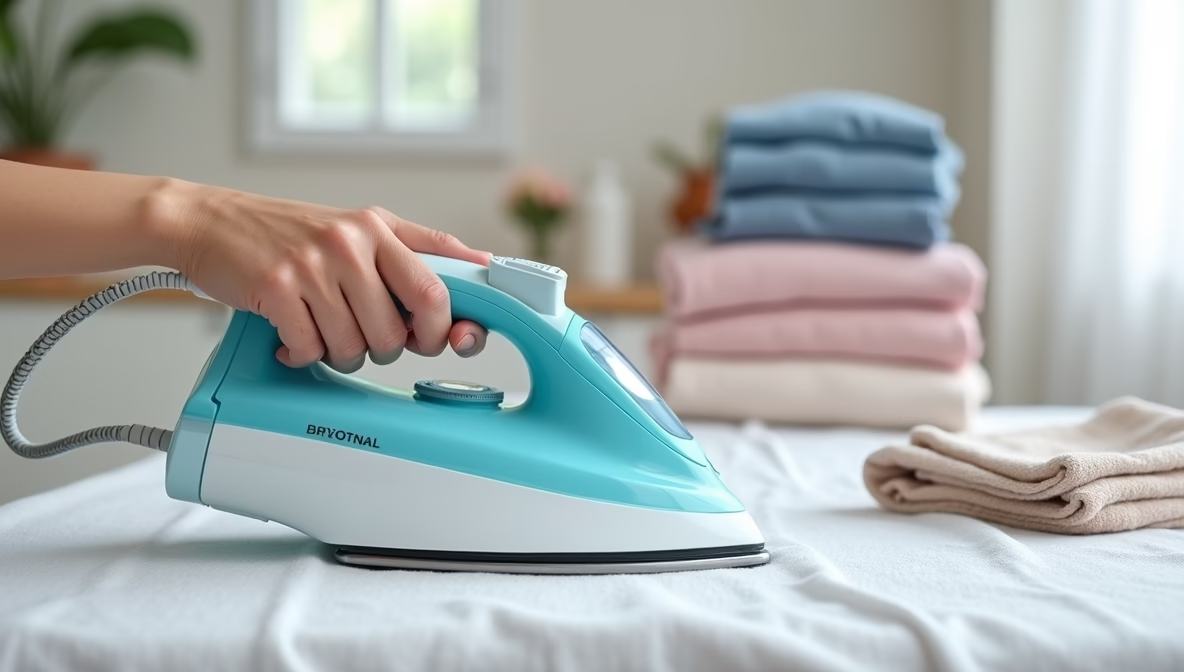
Leave a Reply